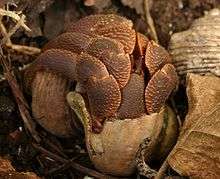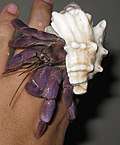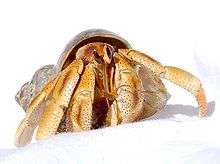Coenobita
The genus Coenobita contains 17 species of terrestrial hermit crabs.[1]
- The junior homonym Coenobita Gistl, 1848 is now the moth genus Ectropis.
| Coenobita | |
|---|---|
| Caribbean hermit crab, C. clypeatus | |
| Scientific classification | |
| Kingdom: | |
| Phylum: | |
| Subphylum: | |
| Class: | |
| Order: | |
| Superfamily: | |
| Family: | |
| Genus: | Coenobita Latreille, 1829 |
| Type species | |
| Pagurus clypeatus | |
Ecology
Coenobita species carry water in the gastropod shells they inhabit, allowing them to stay out of water for a long time.[2]
Distribution
The majority of the species are found in the Indo-Pacific region, with only one species in West Africa, one species occurring along the Atlantic coast of the Americas, and one species occurring on the Pacific coast of the Americas.[3]
| Image | Species | Authority | Year | Distribution [3] |
|---|---|---|---|---|
 | Coenobita brevimanus | Dana | 1852 | Indo-Pacific |
| Coenobita carnescens | Dana | 1851 | Pacific Ocean | |
 | Coenobita cavipes | Stimpson | 1858 | Indo-Pacific |
| Coenobita clypeatus | (Fabricius) | 1787 | Western Atlantic | |
.jpg) | Coenobita compressus | H. Milne-Edwards | 1836 | Eastern Pacific |
| Coenobita longitarsis | De Man | 1902 | East Indies | |
| Coenobita olivieri | Owen | 1839 | Pacific Ocean | |
| Coenobita perlatus | H. Milne-Edwards | 1837 | Indo-Pacific | |
| Coenobita pseudorugosus | Nakasone | 1988 | Indo-Pacific | |
 | Coenobita purpureus | Stimpson | 1858 | Japan |
| Coenobita rubescens | Greeff | 1884 | West Africa | |
 | Coenobita rugosus | H. Milne-Edwards | 1837 | Indo-Pacific |
| Coenobita scaevola | (Forskål) | 1775 | Indian Ocean, Red Sea | |
| Coenobita spinosus | H. Milne-Edwards | 1837 | Polynesia & Australia | |
 | Coenobita variabilis | McCulloch | 1909 | Australia |
 | Coenobita violascens | Heller | 1862 | Pacific Ocean |
Taxonomy
Coenobita is closely related to the coconut crab, Birgus latro, with the two genera making up the family Coenobitidae. The name Coenobita was coined by Pierre André Latreille in 1829, from an Ecclesiastical Latin word, ultimately from the Greek κοινόβιον, meaning "commune"; the genus is masculine in gender.[4]
gollark: (osmarks internet radio™ lasers are not in fact radio-based and thus masers, but merely encode osmarks internet radio™ as phase-modulated X-rays)
gollark: Deploying osmarks internet radio™ lasers.
gollark: I refuse to acknowledge such decisions, so they don't actually exist.
gollark: According to GTech™ legal system 690365, we are entirely in the right on this and it is within our rights to subject you to orbital laser strikes due to the false allegations.
gollark: This is factually incorrect.
References
- Patsy McLaughlin (2009). Lemaitre R, McLaughlin P (eds.). "Coenobita Latreille, 1829". World Paguroidea & Lomisoidea database. World Register of Marine Species. Retrieved January 4, 2012.
- D. R. Khanna (2004). Biology of Arthropoda. Discovery Publishing House. ISBN 978-81-7141-897-8.
- Richard G. Hartnoll (1988). "Evolution, systematics, and geographical distribution". In Warren W. Burggren & Brian Robert McMahon (ed.). Biology of the Land Crabs. Cambridge University Press. pp. 6–54. ISBN 978-0-521-30690-4.
- Gary J. Morgan & L. B. Holthuis (1989). "Nomenclatural problems associated with the genus Coenobita Latreille, 1829 (Decapoda, Anomura)" (PDF). Crustaceana. 56 (2): 176–181. doi:10.1163/156854089X00068. JSTOR 20104437.
External links

This article is issued from Wikipedia. The text is licensed under Creative Commons - Attribution - Sharealike. Additional terms may apply for the media files.